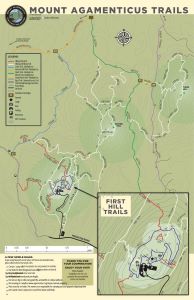Greetings from the Kids’ Corner at Mount Agamenticus! For our sixth season, we’re going digital, and we hope you’ll join us!
It’s bird migration time and Mrs. J is here to help with basic bird identification by sharing resources, photos, and arts and crafts activities to help you learn!
Much of the information shared below comes from the Cornell Lab of Ornithology. This is a wonderful resource for bird enthusiasts, and we encourage families to visit their website and to check out their bird identification app, Merlin. We’ll be sharing links to more resources as our lessons progress!
Another great tool from Cornell is eBird, which allows you to record bird sightings while out in the field. Check out this link for eBird Essentials and a tutorial from the Cornell “Bird Academy.”
This week we’re continuing to hone our bird identification skills with a look at habitat or…
Don’t go Looking for Seagulls in the Forest!
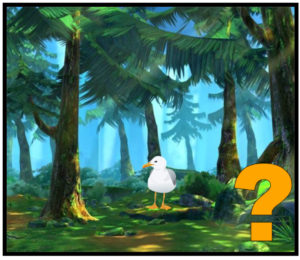
If you would like to download this unit as a printable PDF with some additional photos and illustrations, you can click here. Otherwise, continue reading below!
This last unit introduces us to an important word, habitat:
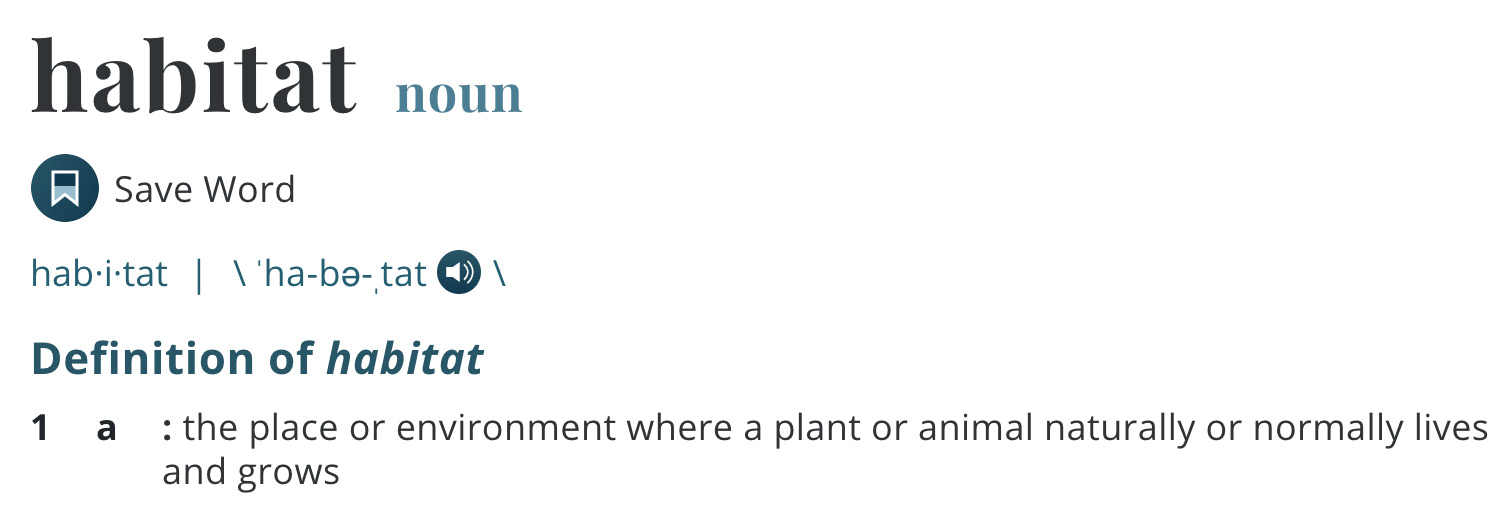
From Merriam Webster
A bird’s habitat is where it finds the necessities for survival: food, water, shelter, and nesting.
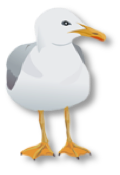 Our seagull (Herring gull) isn’t likely to find a great expanse of water, wide open spaces, or a rocky ledge overlooking the water where it can make a nest and raise its young, in a forest where there are so many trees growing close so together.
Our seagull (Herring gull) isn’t likely to find a great expanse of water, wide open spaces, or a rocky ledge overlooking the water where it can make a nest and raise its young, in a forest where there are so many trees growing close so together.
There are generally four types of habitat that birds like to call their home:
- Woodland habitats – coniferous or deciduous trees;
- Aquatic (watery) habitats – lakes, ponds, swamps, marshes, oceans, and shorelines;
- Scrub-shrub habitats – short woody plants and bushes; and
- Open habitats – grasslands, agricultural fields, and tundra.
Once you learn what kinds of birds depend on each habitat you have a quick tool to help identify birds in the field.

Photo from MacPhail Woods
This beautiful bird lives right here in the woodlands of Maine. It’s called an Ovenbird because of the shape of its nest, usually found right on the ground. Look at the photo. What kind of habitat from the list above do you think the Ovenbird needs in order to build its nest and raise its young?
Woodland Habitats: coniferous or deciduous trees
Conifers are trees that produce cones, like pine cones.
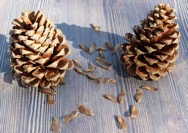
Sometimes coniferous trees are called “evergreens,” which helps us remember that the keep their “leaves” all year long. Evergreen plants can be trees or shrubs and provide food and shelter to birds. They eat the seeds and berries, and the hardy needle branches offer protection against the weather (especially in winter) and predators (which makes evergreens an excellent place for nesting).
 Deciduous trees and shrubs lose their leaves usually in the fall. They do this to better survive the winter, but don’t give a lot of shelter for birds. But, they’re a huge benefit to birds once the leaves return. When birds return to their norther breeding grounds, it is not a coincidence that the deciduous plants are just beginning to bloom. The number one food source for birds is insects, and deciduous trees and shrubs are home to thousands. Plus, they provide other bird foods like seeds, nuts, berries, sap, and nectar.
Deciduous trees and shrubs lose their leaves usually in the fall. They do this to better survive the winter, but don’t give a lot of shelter for birds. But, they’re a huge benefit to birds once the leaves return. When birds return to their norther breeding grounds, it is not a coincidence that the deciduous plants are just beginning to bloom. The number one food source for birds is insects, and deciduous trees and shrubs are home to thousands. Plus, they provide other bird foods like seeds, nuts, berries, sap, and nectar.
Birds like the robin, the chickadee, and many kinds of warblers can all be found in woodland habitats.
Aquatic Habitats: ocean shores, lakeshores, rivers, and wetlands

Photograph by Phil Stone, used with permission.
Seagulls like to nest in the rocky cliffs, but the Piping plover, a rare shorebird, likes to nest right on the beach! This plover has a worldwide breeding population of only 8,400 birds. Notice how the eggs are camouflaged by the beach sand. Still, the Piping plover’s numbers are declining due to unintentional interference by humans; trampling; dogs; vehicles; predation by cats, rats, crows, seagulls, and more; changes in water levels, and destruction of habitat. On some of our beaches, their nesting areas are fenced off to help protect them.

Notice on the map to the right how the habitat of the Piping plover is along the ocean shores in the northeast and along lakeshores, rivers, and wetlands in the northern Great Plains and Great Lakes – aquatic habitat.
 Activity: Paper Mâché Seagull. Follow along and make a paper mâché seagull with Mrs. J! Where does your gull live? Join us on Facebook to share your creations. Remember to tag #MtAKidsCorner2020!
Activity: Paper Mâché Seagull. Follow along and make a paper mâché seagull with Mrs. J! Where does your gull live? Join us on Facebook to share your creations. Remember to tag #MtAKidsCorner2020!
- Step-by-Step PDF craft guide available here.
Scrub-Shrub Habitats: short woody plants and bushes
The Mount Agamenticus summit area is a well-managed scrub-shrub habitat which is critical for birds. The flowering plants provide nectar, seeds, and insects so necessary to breeding birds. Tall herbs, grasses and woody vegetation offer shelter and nest sites, as well as hunting areas for predatory birds such as owls, hawks and kestrels. Individual species of scrub-shrub birds have unique habitat requirements for nesting and feeding.
The Prairie warbler and the Eastern towhee, shown below, both can be found in the Mount A scrub-shrub habitat.
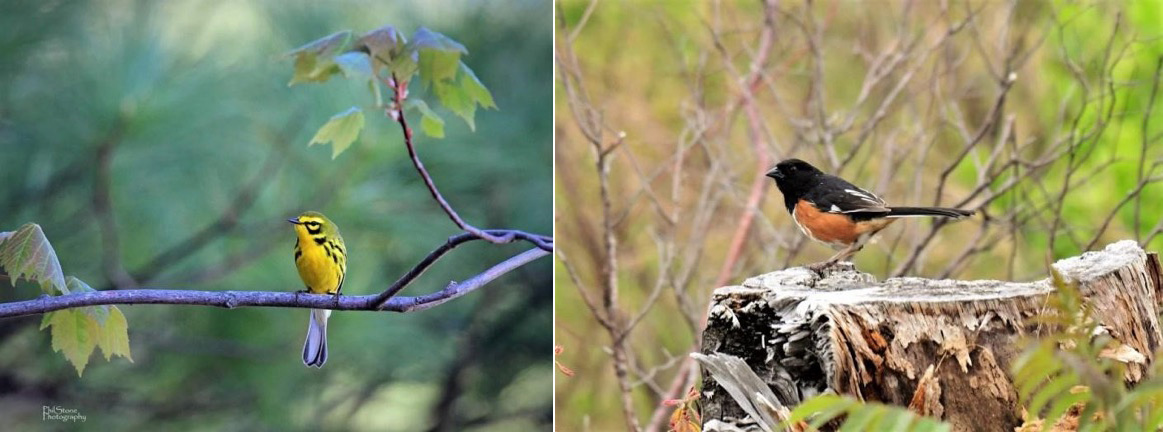
Photos of Prairie warbler and Eastern towhee taken at Mount Agamenticus by Phil Stone, used with permission.
A Closer Look…
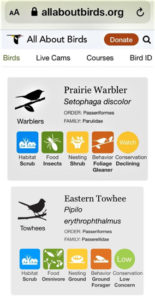
All About Birds from the Cornell Lab of Ornithology
If you consult All About Birds and search for your bird, Cornell will give you the keys to your bird’s habitat right on the first Overview page.
In the screencaptures shown to the left, you can see the Prairie warbler’s habitat is scrub, and it usually nests in a shrub. The chart tells us that it eats all kind of insects by picking them off leaves/foliage and that its numbers are declining, mostly due to loss of – you guessed it, habitat.
You can see that the Eastern towhee shares the same habitat as the Prairie warbler, has a different kind of diet, and makes its nest on the ground.
Open Habitats: grasslands, agricultural fields, and tundra
Both of the following species of bird like to hang out in open habitats, the Savannah sparrow and the Snowy owl.
Snowy owls breed and nest way up in the Arctic Tundra where there are few trees. In years when lemmings (small mammals) are plentiful, these owls can raise up to ten or more chicks. When they come south for the winter, especially in years when lemmings are not plentiful, we see them here in Maine in habitats that are open and look somewhat similar to their Arctic habitat.

Snowy owls at Mount A (left) and Nubble (right). Photos by Mrs. J.
Often that means they hang out near the ocean and around marshes and fields – even out at Nubble Lighthouse and the summit of Mount Agamenticus.

Savannah Sparrow Range
The Savannah sparrow loves open fields, meadows, salt marshes, prairies, grassy dunes, shores, pastures, edges of marshes, alfalfa fields; also tundra in summer, shores and weedy vacant lots in winter! Males can often be easily seen perched atop plants. As you can see on the map, it has quite a large range all over the U.S.
Savannah sparrows eat insects and spiders, including beetles, grasshoppers, and millipedes – swallowing them whole. They’ll even eat spittlebug nymphs inside the foamy froth that appears on goldenrod plants. In winter, they’ll eat mostly small seeds from grasses and near the coast they may even eat tiny crustaceans.
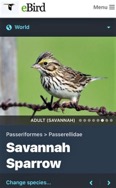
eBird from the Cornell Lab of Ornithology
It’s quite fascinating to see the photos taken by people who report their sightings of Savannah sparrows to Cornell’s eBird site. Click through here to view the sightings that have photos and read who took the photo, when, and especially WHERE they saw them. You can use the LOCATION drop-down to add your town and state to find out WHERE near you that you might go to find a Savannah sparrow.
Activity: Habitat Match. Now that you’re familiar with many different bird habitats, see if you can help these birds find their way “home!”
- Activity Sheet available here.
Activity: Backyard Birds Data Sheet. Put what you’ve learned to the test and use this sheet when identifying birds in your own backyard.
- Activity Sheet available here.
 Let’s talk binocs! Interested in getting a little more serious about birding? Mrs. J has collected some additional resources on binoculars that you may find helpful! Click here.
Let’s talk binocs! Interested in getting a little more serious about birding? Mrs. J has collected some additional resources on binoculars that you may find helpful! Click here.
Last modified: June 21, 2020


